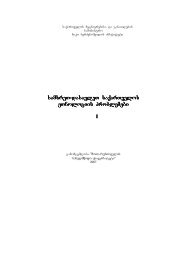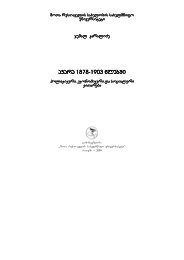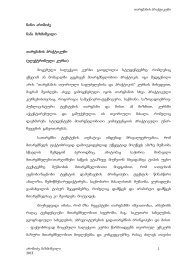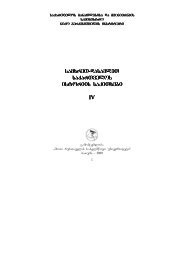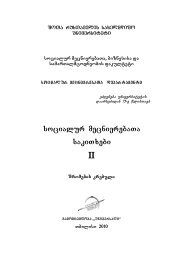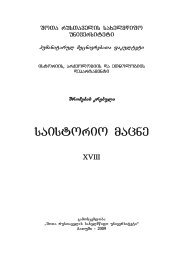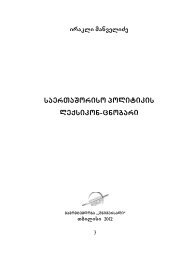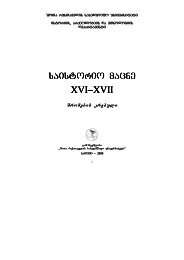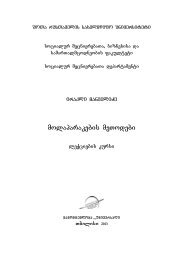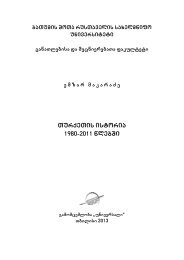Cveni sulierebis balavari II
Cveni sulierebis balavari II
Cveni sulierebis balavari II
- No tags were found...
Create successful ePaper yourself
Turn your PDF publications into a flip-book with our unique Google optimized e-Paper software.
G. LortkipanidzeEarly Christian Stella from Bichvinta TombAs a result of many years archeological excavations there is found ratherlarge 3,5 hectare tomb of a late antique epoch. There were buried Pitiunti fortresslegionaries and members of their families in <strong>II</strong>-IV centuries, representatives of citypopulation of medium and low level (G. Lortkipanidze – 1991, 114-117 p.). Therehave not been detected rich toms except robbed remains of tomb #24 framed withmarble columns (G. Lortkipanidze – 1991, 143 p.).In 1990 in the central hollow of the tomb under a soddy layer there wererevealed remains of later non-fundamental circular construction of identifiedassignment. In the arrangement, together with pebbles and conglomerate there wasfound sandstone tile of unusual length. Its sizes: 73,7 cm x 30 cm (picture 1), base isincomplete, its underground part is 12 cm 4 cm. When overturning the tile it wasrevealed rather significant circumstance. 10 cm away from its upper edge it was asecret net – 13,2 cm x 7 cm, 2,5 cm deep. It was inserted a flat hammered iron cross(picture 2) in the niche incised in the stone, Christian symbol of immortal life anddisengagement from torture. the niche preserved not only the cross but also itsdistinct imprint on the stone (11 cm x 4,5 cm). The sign is rusty trace remained withcorrosion. The net had a ceramic valve 13 cm x 7 cm and 0,7 cm thick. It is made oflocal reddish tile. It is a noticeable imprint of overlapping in edges. The cover wasinserted in the net with a limestone solution to hide the cross from the alien eye, inparticular, from pagans.Obviously it is a grave sandstone. A columnar Stella was erected on a graveof Christ’s secret adept. Later the grave stone was used as a construction one due towhich its nature was not revealed. On this area there were dug several gravesarranged by Christian order. We suppose that the Stella might be erected on thegraver when Christians were persecuted in the Rome Empire which took place till313 A.D., till the famous Milan edict approved by Constantine Great. Sources havereliably confirmed the fact of Christians persecution from Nero epoch (54-58 A.D.)till <strong>II</strong>-<strong>II</strong>I century (Friedrich Anders, Bjorn Onken und Martin Pujila, 2007, pp. 50-52; M. Mshvildadze 2007, p. 84)The cross form provides us with the opportunity to date the Stella;proceeding from available analogies, we may attach the Stella creation time to earlyChristian epoch (Dalton O. M., 1961, pp.506, 507, 509, Fig. 302-303, 305), inparticular, between end of <strong>II</strong>I century and beginning of IV century. Professor M.Mshvildadze considered significance of the secret section of the Stella revealing anddated it as a monument of <strong>II</strong>I century as by that time Christian tombs were ratherfrequent along Bichvinta pagan tomb (Mshvildadze M., 2008, p. 82).Therefore, the iron cross revealed in Bichvinta tomb is the oldest one notonly in Georgia but also in all Christian countries. We believe it will attract experts’attention again.bibliografiag. lorTqifaniZe. biWvintis naqalaqari. Tb. 1991m. mSvildaZe. adreuli qristianoba saqarTveloSi. Tb. 2008D.M. Dalton. Byzantine Art and Archaeology. New York, 1961.F. Anders, B. Onken, M. Pujiota. Spantike Bamberg, 2007.11




